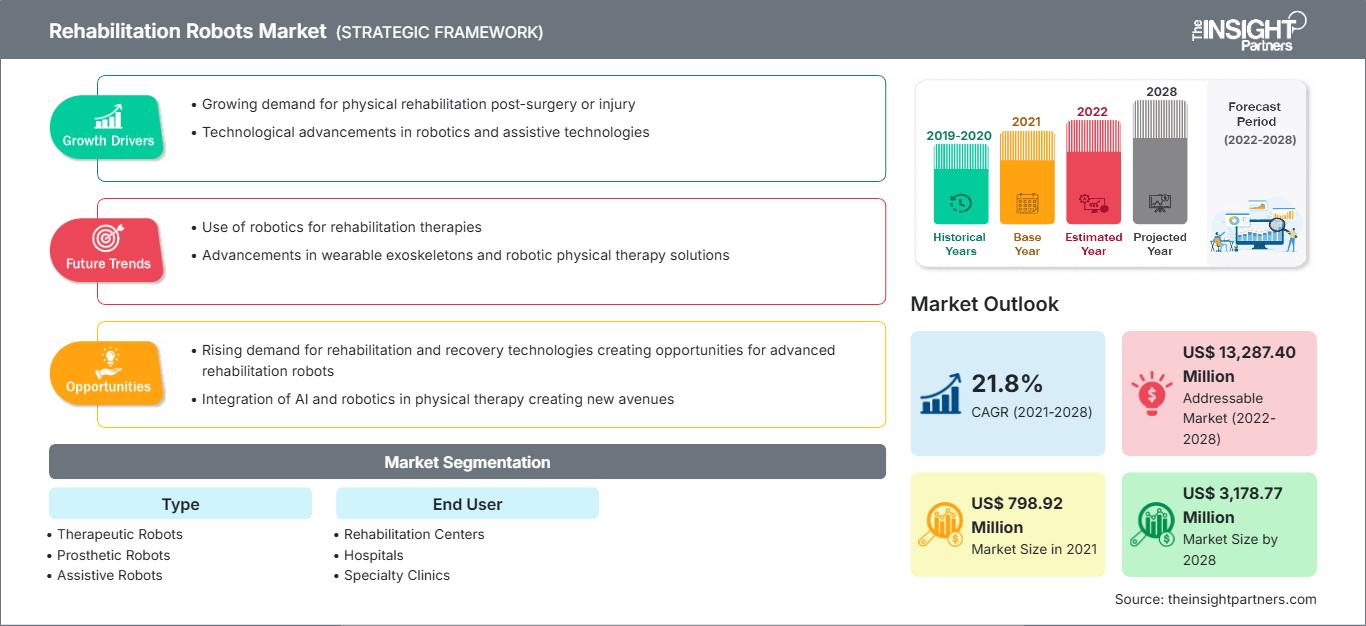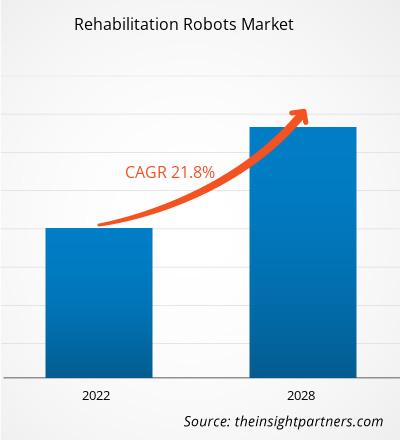Il mercato dei robot riabilitativi è stato valutato a 798,92 milioni di dollari nel 2021 e si prevede che raggiungerà i 3.178,77 milioni di dollari entro il 2028; si prevede una crescita a un CAGR del 21,8% dal 2021 al 2028.
I robot riabilitativi vengono utilizzati nel processo di recupero dei pazienti disabili nell'alzarsi in piedi, nell'equilibrio e nella deambulazione. Questi robot devono tenere il passo con gli esseri umani e i loro movimenti; pertanto, durante la produzione della macchina, i produttori devono garantire che sia coerente con i progressi del paziente. Si prevede che il mercato dei robot riabilitativi registrerà una crescita significativa nei prossimi anni a causa di fattori quali l'aumento della popolazione geriatrica, l'ictus e la formazione assistita da robot nella terapia riabilitativa. Tuttavia, l'elevato costo dei dispositivi ostacolerà la crescita del mercato.
Approfondimenti di mercato
Personalizza questo rapporto in base alle tue esigenze
Potrai personalizzare gratuitamente qualsiasi rapporto, comprese parti di questo rapporto, o analisi a livello di paese, pacchetto dati Excel, oltre a usufruire di grandi offerte e sconti per start-up e università
Mercato dei robot riabilitativi: Approfondimenti strategici

- Ottieni le principali tendenze chiave del mercato di questo rapporto.Questo campione GRATUITO includerà l'analisi dei dati, che vanno dalle tendenze di mercato alle stime e alle previsioni.
Potrai personalizzare gratuitamente qualsiasi rapporto, comprese parti di questo rapporto, o analisi a livello di paese, pacchetto dati Excel, oltre a usufruire di grandi offerte e sconti per start-up e università
Mercato dei robot riabilitativi: Approfondimenti strategici

- Ottieni le principali tendenze chiave del mercato di questo rapporto.Questo campione GRATUITO includerà l'analisi dei dati, che vanno dalle tendenze di mercato alle stime e alle previsioni.
Aumento della popolazione geriatrica, ictus e formazione assistita da robot nella terapia riabilitativa
Con la crescita della ricerca relativa alla robotica riabilitativa, la produzione e l'implementazione di robot terapeutici riabilitativi stanno aumentando in tutto il mondo. Giappone e Cina sono tra i paesi dell'Asia-Pacifico con un'elevata popolazione anziana; questi paesi, così come altre nazioni in via di sviluppo della regione, stanno assistendo ai progressi della tecnologia medica. Secondo il Ministero degli Affari Interni e delle Comunicazioni, circa 35,2 milioni di persone in Giappone avevano 65 anni o più nel 2017 e si prevede che questa cifra salirà a 36,2 milioni entro il 2020. Pertanto, le principali aziende del settore sanitario sono disposte a investire nello sviluppo di tecnologie avanzate per fornire assistenza agli anziani residenti nella regione. Pertanto, l'aumento della popolazione anziana e la crescente prevalenza di ictus, che rende le persone immobilizzate, sono tra i fattori significativi che guidano la domanda di robot riabilitativi.
La terapia riabilitativa robotica viene utilizzata per fornire un allenamento ad alta intensità a pazienti affetti da disturbi motori causati da patologie del midollo spinale o ictus. L'ictus è una delle principali cause di grave disabilità a lungo termine negli Stati Uniti, secondo i Centers for Disease Control and Prevention (CDC). Affaticamento, emiparesi e difficoltà di deambulazione sono alcune delle conseguenze di un ictus. Inoltre, i robot riabilitativi forniscono un allenamento personalizzato, orientato alle attività, prolungato, intensivo, standardizzato e riproducibile ai pazienti affetti da ictus o altre lesioni cerebrali non progressive. Pertanto, la crescente domanda di servizi sanitari migliori e più rapidi guida la crescita del mercato complessivo dei robot riabilitativi.
Approfondimenti sulla tipologia
In base alla tipologia, il mercato dei robot riabilitativi è segmentato in robot terapeutici, robot assistivi, robot esoscheletrici e robot protesici. Il segmento dei robot esoscheletrici ha detenuto la quota maggiore di mercato nel 2021 e si prevede che registrerà il CAGR più elevato durante il periodo di previsione.
Utente finale
In base all'utente finale, il mercato dei robot riabilitativi è segmentato in ospedali, centri di riabilitazione e cliniche specialistiche. Il segmento dei centri di riabilitazione ha detenuto la quota maggiore di mercato nel 2021 e si stima che registrerà il CAGR più elevato durante il periodo di previsione.
Gli operatori che operano nel mercato dei robot riabilitativi hanno adottato in modo significativo la strategia di innovazione di prodotto per soddisfare la mutevole domanda dei clienti in tutto il mondo, il che consente loro anche di mantenere il proprio marchio a livello globale.
Approfondimenti regionali sul mercato dei robot riabilitativi
Le tendenze regionali e i fattori che influenzano il mercato dei robot riabilitativi durante il periodo di previsione sono stati ampiamente spiegati dagli analisti di The Insight Partners. Questa sezione analizza anche i segmenti e la distribuzione geografica del mercato dei robot riabilitativi in Nord America, Europa, Asia-Pacifico, Medio Oriente e Africa, America meridionale e centrale.
Ambito del rapporto di mercato sui robot riabilitativi
| Attributo del rapporto | Dettagli |
|---|---|
| Dimensioni del mercato in 2021 | US$ 798.92 Million |
| Dimensioni del mercato per 2028 | US$ 3,178.77 Million |
| CAGR globale (2021 - 2028) | 21.8% |
| Dati storici | 2019-2020 |
| Periodo di previsione | 2022-2028 |
| Segmenti coperti |
By Tipo
|
| Regioni e paesi coperti | Nord America
|
| Leader di mercato e profili aziendali chiave |
|
Densità degli attori del mercato dei robot riabilitativi: comprendere il suo impatto sulle dinamiche aziendali
Il mercato dei robot riabilitativi è in rapida crescita, trainato dalla crescente domanda degli utenti finali, dovuta a fattori quali l'evoluzione delle preferenze dei consumatori, i progressi tecnologici e una maggiore consapevolezza dei vantaggi del prodotto. Con l'aumento della domanda, le aziende stanno ampliando la propria offerta, innovando per soddisfare le esigenze dei consumatori e sfruttando le tendenze emergenti, alimentando ulteriormente la crescita del mercato.

- Ottieni il Mercato dei robot riabilitativi Panoramica dei principali attori chiave
Per tipo
- Robot esoscheletrici
- Robot terapeutici
- Robot di assistenza
- Robot protesici
Utente finale
- Centri di riabilitazione
- Ospedali
- Cliniche specialistiche
Per area geografica
- Nord America
- Stati Uniti
- Canada
- Messico
- Europa
- Regno Unito
- Germania
- Francia
- Italia
- Spagna
- Resto d'Europa
- Asia Pacifico
- Cina
- Giappone
- India
- Australia
- Sud Corea
- Resto dell'Asia Pacifica
- Medio Oriente e Africa
- Emirati Arabi Uniti
- Arabia Saudita
- Sudafrica
- Resto del Medio Oriente e Africa
- America meridionale e centrale
- Brasile
- Argentina
- Resto dell'America meridionale e centrale
Profili aziendali
- Bionik Laboratories Corporation
- Cyberdyne Inc.
- Ekso Bionics Holdings Inc
- Rewalk Robotics Ltd
- Hocoma Ag
- Rehab-robotics Company Limited
- Kinova Inc
- Rex Bionics Ltd
- Toyota Motor Corporation
- Myomo Inc
- Analisi storica (2 anni), anno base, previsione (7 anni) con CAGR
- Analisi PEST e SWOT
- Valore/volume delle dimensioni del mercato - Globale, Regionale, Nazionale
- Industria e panorama competitivo
- Set di dati Excel
Report recenti
Testimonianze
Motivo dell'acquisto
- Processo decisionale informato
- Comprensione delle dinamiche di mercato
- Analisi competitiva
- Analisi dei clienti
- Previsioni di mercato
- Mitigazione del rischio
- Pianificazione strategica
- Giustificazione degli investimenti
- Identificazione dei mercati emergenti
- Miglioramento delle strategie di marketing
- Aumento dell'efficienza operativa
- Allineamento alle tendenze normative




















 Ottieni un campione gratuito per - Mercato dei robot riabilitativi
Ottieni un campione gratuito per - Mercato dei robot riabilitativi